Continuing our look at the inhabited islands of Croatia on January 29, 2017, the fabulous island of Lastovo and its famous carnival through the eyes of Ivor Igrec, in collaboration with the Island Movement, Pokret Otoka.
HOW IT ALL BEGAN
The story begins on a characteristically grey Zagreb day at the very end of last year, in a busy bar in Tkalčićeva street, where my colleagues and I agreed, for many reasons, it would be very nice to visit Lastovo island soon.
The goal was to arrange a business trip and Lastovo scouting in order to gather information and meet with all who could support the formation and functioning of a summer artist colony on the island. Forming it would give artists from any part of this third rock from the sun a chance to be inspired by the island in creating their artwork. Their ultimate goal would be to culturally enrich the area and bring inspiration to the island, not just for the artists, but for visitors and residents as well. Primarily, the island was supposed to be an inspiration and a generator of ideas so we zeroed in on visiting the island during the Lastovski Poklad, a popular and authentic carnival tradition found in various version in all of the Adriatic, held without breaks for half a millennium. The earliest mention of it reaches to the end of the 16th century.
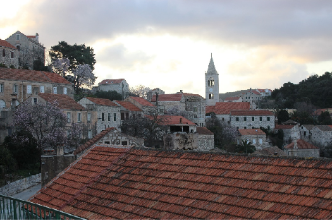
The origin of Poklad is tied to the arrival of Catalonian or Saracen pirates to the area, after their attack on neighbouring Korčula. According to legend, the pirates sent a Turkish messenger who was to order the islanders to surrender or suffer the same fate as Korčula folk. But the Lastovo residents did not scare easily and decided to attack. Women and children were sheltered inland, heading on foot to Hum, praying to St. George for help. The legend says their prayers were heard and a storm destroyed the pirate fleet, while islanders captured the messenger in order to humiliate him. Before he died, he was taken through the settlement on the back of a donkey after which he was sentenced to death by bonfire. The procedure and ceremony of burning the Poklad puppet, held since then every Tuesday before Ash Wednesday, sent a clear message to comrades of the fallen pirates, not to attempt the same as the islanders were ready to do whatever to protect their freedom and way of life. Piracy was also the reason why Lastovo town is inland where defence and evacuation were easier to prepare. Lastovo residents only began to migrate to shore since the 18th century when local pirates, especially the ones from Ulcinj, realised it pays more to do honest jobs such as fishing, and some slightly less honest such as trade, instead of risking the fate of the burned Turkish messenger who inspired the custom.
The symbolism of Lastovski Poklad can be explained in observing several carnival rituals. The ceremony of ‘culjanje,’ hanging of the Poklad puppet and its rope-sliding accompanied by the explosion of fire-crackers, and its ultimate end on the bonfire, can be seen as a purification by air and fire, meaning a ritual cleansing of the entire community from all the evils which it faced during the previous year. Also, the gathering of eggs and binding of masked participants in carnival dances can be viewed as a ritual of initiation and fertility, considering Lastovo has from the beginning been a community of farmers and cattle breeders. The culjanje takes place in silence as its fall from the rope or while it is being carried forebodes a year of bad harvest. During the carnival days the entire island comes alive from the usual dormancy of winter life on the island, considering many Lastovo natives come from far away, many from North and South America and Australia to enjoy the festivities.
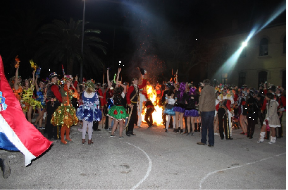
FIRST HOURS ON LASTOVO
Our departure to Lastovo was a textbook example of combining pleasure and purpose with plenty of both, so much that I would now rather spend time in bed with a cup of hot cocoa, if my fresh and strong impressions didn’t push me to share the experience with others. The arrival of our dear friend and colleague Andrej to Split and the boarding of the ferry to Lastovo, our small odyssey began. It soon earned that title as it seemed Poseidon himself was after us, considering the waves that relentlessly smashed upon us. The ferry would have been very spacious and pleasant if it wasn’t for the storm outside worthy of Cape Horn and I must admit I felt for the first time what it means to be seasick. The most visible consequence of the swaying was on my face which changed colours with astonishing speed and contrast. In quick succession it went through all the primary, secondary and tertiary colours.
After a five-hour bobbing on the Adriatic and a welcome, but short respite in Vela Luka harbour, the ferry sailed into Ubli, a doorstep to the world of Lastovo. We will return to Ubli later, the only thing visible that evening in a thin line of lights along the coast was the harbour master’s building, bar and gas station. Next to it was a bus to Lastovo town which took us directly to our hosts, owners of the apartment we had rented. In the morning we discovered Lastovo is sprawled on the slopes of hills that surround a valley where the newly renovated Lastovski Poklad Square sits. The morphology of the terrain associates of a Greek theatre in which houses are radially dispersed as an auditorium, while the pit with the square can be seen as Lastovo’s stage, soon to be confirmed in many ways, not just by position.
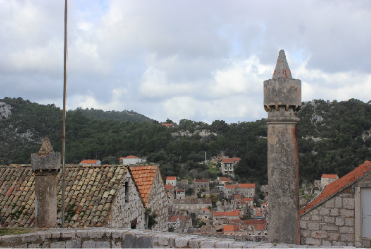
Regardless of the darkness we could already see the most characteristic architectural element of Lastovo. Old Lastovo residents built their chimneys in competition to make them as beautiful, strong and large as possible, with each new chimney more original and unusual than the last, so some have animal horns placed as curses or mockery of the neighbours. The entire rivalry reminded me of a lesser known race, the one that resulted in the construction of numerous towers and forts of San Gimignano. Also, Lastovo is a place where old houses have a dominating red clay roof, instead of typical stone slabs found on most old Dalmatian homes. The reason lies in one of many influences left on the island by its short-term Italian administration, which furnished each household with cheap and accessible clay roofs.
Our hosts introduced the island in the best light and regardless of the fatigue and lingering traces of nausea, I was intrigued by their praise for domestic fruit and vegetables which seemed to resist modern practices of artificial cultivation. I was convinced this part is true for at least the grapes and its products, as the excellent Lastovo wine soon erased any traces of the haphazard arrival to the island. Still, considering we had an early morning meeting with the district chief who was an unavoidable reason for our arrival, we managed to wrestle out of the charms of Lastovo wine early enough to at least arrive before the chief without bags under our eyes.
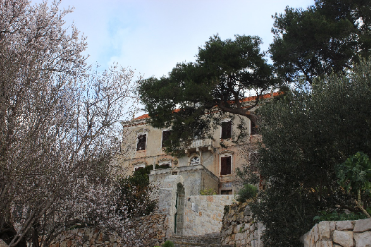
DAY ONE: MEETING LASTOVO AND NOCTURNAL HOUSE/BAR CRAWL
Placing the respite level aside, the morning meeting went very well so our plans in terms of the activity space began to have a clearer frame. Also, the chief decided to use some of his time and tour with us later through one of the possible locations where the colony could take place, which, considering he was busy with organising the Poklad, was a very generous concession in his hectic schedule. We had the opportunity to scout a location in the Lučice area, one of the closest sea contacts from Lastovo some 10 minutes away. Along the path were many rocks in which someone recognised animal and human shapes, spraying in their eyes and mouths, a slight attempt to make Lastovo into Easter island. A quick tour of Lučice, preserved and renovated with the effort of locals, the scenery was dominated by the red-orange colour of clay roofs and olive green colour of wooden doors and window shades.
After asserting the location would be potentially good for housing artists, or us for that matter, tall waves and empty stomachs chased us back to the centre of Lastovo. In one of the centres of Poklad preparations, the restaurant Bačvara, work was nearly complete on the straw puppet and its covering with a ceremonial costume. It was then that I first heard the Lastovo lira whose characteristic and piercing sound would mark all events in the next two days, as well as something islanders call halekanje, a very specific vocalisation of the Poklad shout “Uvo,” three times in a row, at all important daily ceremonies of Poklad. The restaurant is the scene of dance evenings organised only in Poklad period, called balo. After a lunch dominated by pasta and many pitchers of red and white wine, we went to meet the chief at another potential location of our future artist colony – so-called Knežev Dvor (Duke’s Court), especially its annex which could serve as an atelier and storage of unfinished works and materials. I soon learned from the chief there was never a Duke in the building, so the name is quite inaccurate since the current neo-renaissance building was made in the 19th century in place of a demolished object which did serve to house the Dubrovnik administrator of the island who was tributed as a Duke. The interior has been preserved in original form, with wall paintings and preserved wooden furniture and other items. The problems come from a damaged façade and moisture ruining its looks, with the process getting worse if not taken care of. It also seems one of the former owners was too impatient in modernising the place so they left clear scars in bringing electricity to the building. The chief also toured us through the nearby church of St. John the Baptist where he showed us a sizeable collection of items from Lastovo’s past which was perfect for formalising an ethnographic collection in an adequate exhibition space.
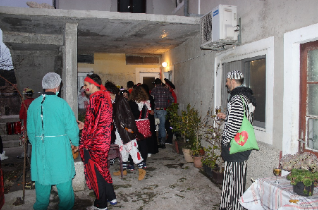
With the end of our meeting with the chief, came the informal part of our day. At one of the Lastovo squares in front of the church of St. Kuzma and Damjan we were met by Bruna, one of the Lastovo friends of our small company, whom we spent a good portion of the day with. She brought with her two costumes, a prisoner for Andrej, while mine was an attempt of combining a drag queen with cartoon characters. All set, we began a long night taking part in a Lastovo custom, gathering eggs in houses. Groups of masqueraded people visit family homes around the town after they were visited by the main group with lira players. There are eggs waiting at the houses, as well as other delicacies and drinks, notably good wine and a characteristic rose brandy. The custom additionally confirmed the Lastovo sensation of unity and hospitability and reminded me of fiesta descriptions accompanied by corridas, experienced by Ernest Hemingway in the north of Spain, which also included complete openness of homes to all visitors, who would leave the streets and continue their feasts in them. The entire evening as made up of plenty of song, music, feasts in family homes. As part of this, we met a girl from Rijeka whose family is from Lastovo. Tea learned from us we wanted to go to Ubli the next morning and experience the area both professionally and personally. We had begun to consider the area as potentially excellent for positioning and working on future sculptures and installations made in the artist colony. As she had accommodation in Ubli, she offered her help in touring the place and nearby Maršalka army outpost, which we gladly accepted.
At the end of the evening we returned to an area called Pjevor, which became important during the course of the day considering it is home to all of the bars as well as the bank, post office and markets so we soon became regulars in the Mamilo bar, so much that the waitress already knew our order. We visited again one of the bars than doubles as a night club, but the crowd and music were not to our taste so we spent the rest of the evening out front. We had to be careful not to sit on eggs that were obviously not cooked for Poklad and the locals used them as projectiles around Pjevor. That night we were not complete retirees like the first night so we attempted to live out the entire night celebrating the arrival the most important day of Lastovski Poklad.
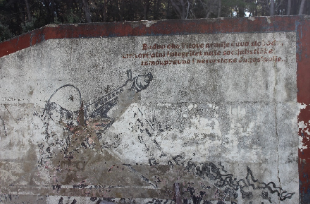
DAY TWO: UBLI, ROPE AND FIRE
Upon waking up the next day we realised that before any expedition to Ubli we needed a coffee in Pjevor, an ideal place to hitchhike since the bus left too early or too late for our taste. In quick succession, thanks to the Lastovo habit of helping travellers, we found ourselves in Ubli quickly. Literally all the drivers we hailed stopped, while only the sixth was on his way to Ubli. Arriving to Ubli I could not escape the feeling of how much the past left a mark on it. From the first antique period settlement until today the remnants of St. Peter’s basilica survived, as well as the villa rustica complex. I also noticed the three sarcophaguses underneath the archaeological dig, especially how endangered they are as it is only a matter of time when ground erosion will happen. As long as I mentioned complete devastation, time in general was not kind to Ubli. After a failed urbanism project in the time of Italian administration, caused by the reluctance of the islanders to relocate to Ubli and work in the newly opened sardine factory, followed by an exodus of Italians which the administration brought to the island to work instead of them, the entire town kept slipping into oblivion. Despite the uplift experienced in socialist Yugoslavia with the construction of the Sirena hotel and military outposts which marked the history of Lastovo, it would cause long term problems for the settlement and the island. The strategic location of Lastovo, just like Vis, caused expansive isolation of the island. Although the arrival of many soldiers and officers brought colour into local life, as our hosts in the apartment explained, many Lastovo women who married them and their children are today in many areas of former Yugoslavia. With the dissipation of that state and everything it represented in the military whirlwind of the 1990s, and with previous dissolution of Italian dreams of a new Roman empire on the Mediterranean, Ubli got hit again and the buildings constructed in both states began to slip into oblivion. Despite the certain charm of the place and immediate environment, Ubli today has an air of a post-apocalyptic settlement where life is trying to come back after a cataclysm.
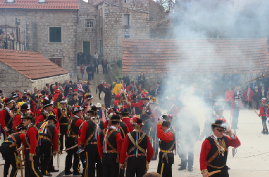
Passing through Maršalka outpost, once a small soldier town of its own, my feeling of a return to some past times increased, especially upon seeing paroles from the former state which were bursting with optimism and unfulfilled desire for an eternal existence of Yugoslavia which would overcome all internal and external challenges. Coming back to the important part, our attempts to find an interesting souvenir from the time soon became unrealistic, since the location of the outpost has been cleaned by hordes of tourists and others so we even failed to find documents from the time which Tea used to be able to find before. Returning to Ubli we experienced interior design from the Italian fascist dictatorship by visiting Tea’s home on whose terrace we had tea and coffee and chatted before our joint departure to the beginning of the main Poklad festivities of the day. During the conversation I learned the island has no poisonous snakes, only to read a few days later an interesting legend that describes the escape of the Illyrian queen Teuta to Lastovo island and how she protected the snake divinity from the Romans and the snakes returned the favour by placing all their strength on the island and removing the threat of venomous snakes from the island.
Upon returning to Lastovo we arrived at the right time to experience the beginning of events on this most festive Poklad day. All the Poklad participants gather with the characteristic red-black uniforms as well as lovely masked folks, when the church and secular representatives give them permission to begin the procession, whose unavoidable part is the sword fight which automatically reminded me of the Moreška dance. Up to a century ago real swords were used, which probably resulted in a large number of injuries and lost fingers, prompting a switch to wooden versions. As the custom is older than any ideas of emancipation, Poklad participants can only be men while women gather in a special group of lovely masks which by tradition must have their own procession and must not meet the main group until the final burning on the main square. Then the last Poklad dances begin ending in the burning of the Poklad puppet which spends the day following the male Poklad group on the back of a donkey. During the entire day, especially as night began to descend I began to worry the lack of material on many costumes would cause issues with the cold since it was the beginning of February, with some dressed as in August, but the more energetic dancing of the carnival folk and availability of good wine certainly cancelled any sense of coldness. I noticed many of the costumes were paired, an old custom that the lovely masks must always go in pairs with identical costumes.
Regardless of how drawn we were with the celebrations, soon our stomachs grumbled and we sought a nice place for lunch. Soon we became aware of how wrong we were to expect that any of the konobas would be open for tourists who came to enjoy the burning of the Poklad puppet. Soon we wished we were made of straw as well so we wouldn’t feel the hunger that set in. After realising all the konobas were closed or reserved for private dinners and parties, we headed to the market in Pjevor, the only store we were convinced should be open but soon saw in panic it was too closed. The Robison Crusoe feeling set in, shipwrecked and hungry on an island so we spent the next few hours surviving off the last apples, cranberries and hazelnuts we luckily saved up.
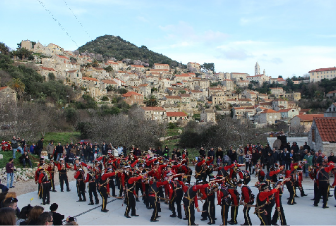
After our failed search we returned to the ceremony to avert our thoughts from the onset of hunger. The Poklad groups were slowly descending to the Lastovski Poklad Square accompanied with lira and singing traditional songs, of which I mostly remember “The Green Orange Came Out” which was continuously performed throughout the day. Occasionally they would stop in certain courtyards and perform their dances and sword fights. Arriving to the square, the culjanje ceremony began, pushing of the puppet, filled with firecrackers, from the top of the hill above the village, sliding on rope to the square, with timed explosions of firecrackers on it. After the culjanje was performed three times and following the dances of the Poklad group and the lovely masks, both groups moved on to the district square where the last Poklad dances took place before the burning of the puppet. After the burning and fireworks the mass of people soon disbanded and went for dinner, preparing for the last dance of Poklad before lent set in. At the end of the evening festivities, our last desperate attempt to find any food prompted the owners of the Fumari konoba to give us reserved tables and very delicious meals, although at that point we were so hungry we would accept shoe soles. After the dinner, our intent on paying for the meal was blocked by the owner, so in spite of our attempts to have her accept money, we left thankful for the meal and with a promise to come back in the summer to compensate with a large and paid meal.
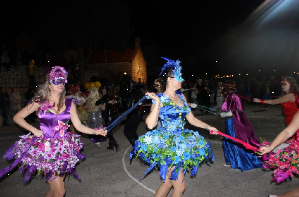
SAYING GOODBYE TO LASTOVO AND RETURN
The evening ended with a ceremonial trip to the Mamilo bar, where we said goodbye to Lastovo with a quick drink and missed out on the final dance. I could say the early bedtime at 22h was due to our endless wisdom as the ferry schedule had us up at 3h in the morning, but that would not be true. In fact it was our complete exhaustion after an eventful day and we needed the rest before our long return, especially for Andrej who had a much longer trip home than me. Our hopes of sleeping on the ferry soon dissipated as that day came a storm that made our arrival feel like a flight of the sparrow. Chairs soon began to fall in the ship’s mess, sometimes with people on them. Looking out the far window I noticed the nearby Hvar island was barely visible considering the ship was swaying so much that the view was filled with sea spray and sky. We arrived to Split quite battered but in one piece. After the last duties of the morning and saying goodbye to Andrej who had a long journey still ahead before he could rest and reflect. Although this adventure lasted just over 48 hours, due to everything we went through, saw, heard, experienced and tasted it seemed a time-space bubble was formed that had different rules, making time go slower. Now, with all those days behind me, I already know they will be part of an exclusive club of days whose abundance of events keeps them forever fresh and clear as they were in the beginning and will serve forever as time markers on the journey we call life.


